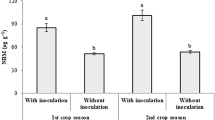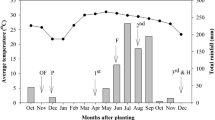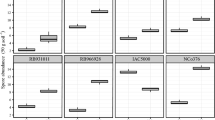Abstract
Purpose
The aim of this research was to determine the vinasse irrigation effects on the arbuscular mycorrhizal fungi (AMF) population (total spore abundance (TSA), richness, relative abundance, and diversity indices) and soil parameters and nutrients at high doses. The irrigation of soil with vinasses derived from sugarcane, beet, or alcohol production is a common practice around the world. Little is known about how this affects the AMF community and soil nutrients.
Materials and methods
The spider plant (Chlorophytum comosum, (Thunb.) Jacques), a mycorrhizable plant, was used to investigate the effect of 4 months of frequent vinasse irrigation (0, 25, 50, 75, and 100% vinasse concentration) on AMF and soil characteristics, e.g., electrical conductivity (EC), pH, mineral N, available P, Na+, K+, Ca2+, and Mg2+.
Results and discussion
The vinasse irrigation decreased the TSA, AMF richness and diversity after 4 months, regardless of vinasse concentration. The vinasse irrigation did not acidify the soil, but the EC, mineral N and available P increased. The biomass of C. comosum decreased (77–81%) after vinasse irrigation for 4 months.
Conclusions
Frequent irrigation with vinasse at concentrations ≥50% increases EC, K+, Na+, Mg2+, Ca2+ and available P in the soil, and decreases the amount of AMF spores, richness and diversity, which is not desirable in agricultural soils.







Similar content being viewed by others
References
Abeysingha NS, Bandara AMKR, Singh S (2017) Effect of Eppawela high graded rock phosphate (HERP) applied with vinasse on yield and quality of sugarcane (variety CO775). Natl Acad Sci Lett 40:253–256
American Public Health Association (1992) Standard methods for the examination of water and wastewater, 18th edn. Washington, DC
Aparecida-Christofoletti C, Pedro-Escher J, Evangelista-Correia J et al (2013) Sugarcane vinasse: environmental implications of its use. Waste Manag 33:2752–2761
Arimi MM, Zhang Y, Götz G, Kiriamiti K, Geißen SU (2014) Antimicrobial colorants in molasses distillery wastewater and their removal technologies. Int Biodeterior Biodegrad 87:34–43
Arnold MA (2009) Chlorophytum comosum. In: Landscape Plants for Texas and Environs, 4th edn
Bai J, Gao H, Xiao R et al (2012) A review of soil nitrogen mineralization as affected by water and salt in coastal wetlands: issues and methods. Clean - Soil Air Water 40:1099–1105
Bengtsson G, Bengtson P, Mansson KF (2003) Gross nitrogen mineralization-, immobilization-, and nitrification rates as a function of soil C/N ratio and microbial activity. Soil Biol Biochem 35:143–154
Bergmark CL, Jackson WA, Volk RJ, Blum U (1992) Differential inhibition by ferulic acid of nitrate and ammonium uptake in Zea mays L. Plant Physiol 98:639–645
Blum U, Dalton BR, Shann JR (1985) Effects of ferulic and p-coumaric acids in nutrient culture of cucumber leaf expansion as influenced by pH. J Chem Ecol 11:1567–1582
Bostyn S, Cagnon B, Fauduet H (2009) Optimization by the simplex method of the separation of phenolic acids by high-performance liquid chromatography in wastewater olive and sugar beet vinasse. Talanta 80:1–7
Braria A, Ahmad S, Harikumar SL (2014) Chlorophytum comosum (Thunberg) Jacques: a review. Int J Pharm 5:546–549
Brundrett M, Bougher N, Dell B et al (1996) Working with mycorrhizas in forestry and agriculture, Canberra
Carbonnel S, Gutjahr C (2014) Control of arbuscular mycorrhiza development by nutrient signals. Front Plant Sci 5:462
CETESB (2006) Vinhaça—critérios e procedimentos para aplicação no solo agrícola
Correia JE, Christofoletti CA, Ansoar-Rodríguez Y, Guedes TA, Fontanetti CS (2017) Comet assay and micronucleus tests on Oreochromis niloticus (Perciforme:Cichlidae) exposed to raw sugarcane vinasse and to phisicochemical treated vinasse by pH adjustment with lime (CaO). Chemosphere 173:494–501
Dametie A, Fantaye A, Teshome Z (2014) Estimating effect of vinasse on sugarcane through application of potassium chloride at Metahara sugarcane plantation. Adv crop. Sci Technol 2:154
Dane JH, Top C (2002) Methods of soil analysis. Part. 4 physical methods. Soil Sci. Soc. am. B. Ser 866
Datta P, Kulkarni M (2012) Arbuscular mycorrhizal fungal diversity in sugarcane rhizosphere in relation with soil properties. Not Sci Biol 4:66–74
Dave S, Tarafdar JC (2012) Arbuscular mycorrhizal fungi encourage drought tolerance of Chlorophytum borivilianum by enhancing antioxidant enzyme system. Appl Biol Res 14:60–70
Dave S, Das J, Tarafdar JC (2011) Effect of vesicular arbuscular mycorrhizae on growth and saponin accumulation in Chlorophytum borivilianum. ScienceAsia 37:165–169
Diacono M, Montemurro F (2011) Long-term effects of organic amendments on soil fertility. In: Lichtfouse E, Hameli M, Navarrete M, Debaeke P (eds) Sustainable Agriculture Volume 2. Springer, Dordrecht, pp 761–786
Do Nascimento R, De Souza JA, Moreira A, Cardoso Moraes LA (2017) Phosphogypsum and vinasse application: soil chemical properties and alfalfa productivity and nutritional characteristics. Rev Caatinga 2125:213–219
Estrada B, Aroca R, Azcón-Aguilar C, Barea JM, Ruiz-Lozano JM (2013) Importance of native arbuscular mycorrhizal inoculation in the halophyte Asteriscus maritimus for successful establishment and growth under saline conditions. Plant Soil 370:175–185
Fernandes C, Garcia H, De Souza RB et al (2017) Toxicity of two effluents from agricultural activity: comparing the genotoxicity of sugar cane and orange vinasse. Ecotoxicol Environ Saf 142_216–221
Fuess LT, Garcia ML (2014) Implications of stillage land disposal: a critical review on the impacts of fertigation. J Environ Manag 145:210–229
Gallego-Blanco J, Munoz E, Hernandez-Rios L (2012) Efectos de aplicación de vinaza mezclada con microrganismos sobre un Vertisol con caña de azúcar. Agron Colomb 30:116–123
González L, Mejía M (2015) Impact of ferti-irrigation with vinasse on groundwater quality. Irrig Drain 64:400–407
Gunes A, Inal A, Alpaslan M, Eraslan F, Bagci EG, Cicek N (2007) Salicylic acid induced changes on some physiological parameters symptomatic for oxidative stress and mineral nutrition in maize (Zea mays L.) grown under salinity. J Plant Physiol 164:728–736
Jiang ZP, Li YR, Wei GP, Liao Q, Su TM, Meng YC, Zhang HY, Lu CY (2012) Effect of long-term vinasse application on physico-chemical properties of sugarcane field soils. Sugar Tech 14:412–417
Laime EMO, Fernandes PD, Oliveira DCS, Freire EA (2011) Possibilidades tecnológicas para a destinação da vinhaça: uma revisão. Rev Trópica Ciências Agrar e Biológicas 5:16–29
Lenoir I, Fontaine J, Lounès-Hadj Sahraoui A (2016) Arbuscular mycorrhizal fungal responses to abiotic stresses: a review. Phytochemistry 123:4–15
Lim SL, Lee LH, Wu TY (2016) Sustainability of using composting and vermicomposting technologies for organic solid waste biotransformation: recent overview, greenhouse gases emissions and economic analysis. J Clean Prod 111:262–278
López-López A, Davila-Vazquez G, León-Becerril E, Villegas-García E, Gallardo-Valdez J (2010) Tequila vinasses: generation and full scale treatment processes. Rev Environ Sci Bio/Technol 9:109–116
Lyu S-W, Blum U, Gerig TM, O’Brien TE (1990) Effects of mixtures of phenolic acids on phosphorus uptake by cucumber seedlings. J Chem Ecol 16:2559–2567
Madejón E, López R, Murillo JM, Cabrera F (2001) Agricultural use of three (sugar-beet) vinasse composts: effect on crops and chemical properties of a Cambisol soil in the Guadalquivir river valley (SW Spain). Agric Ecosyst Environ 84:55–65
Magurran AE (2004) Measuring biological diversity. Blackwell Publishing, Padstow
Mardukhi B, Rejali F, Daei G, Ardakani MR, Malakouti MJ, Miransari M (2011) Arbuscular mycorrhizas enhance nutrient uptake in different wheat genotypes at high salinity levels under field and greenhouse conditions. C R Biol 334:564–571
Mechri B, Mariem FB, Baham M, Elhadj SB, Hammami M (2008) Change in soil properties and the soil microbial community following land spreading of olive mill wastewater affects olive trees key physiological parameters and the abundance of arbuscular mycorrhizal fungi. Soil Biol Biochem 40:152–161
Min K, Freeman C, Kang H, Choi S-U (2015) The regulation by phenolic compounds of soil organic matter dynamics under a changing environment. Biomed Res Int 2015:1–11
Montenegro-Gomez SP (2008) Influencia de la aplicación de vinaza sobre la presencia, actividad y biomasa microbiana del suelo en el cultivo de maíz dulce (Zea mays). Universidad Nacional de Colombia
Moran-Salazar RG, Sanchez-Lizarraga AL, Rodriguez-Campos J, Davila-Vazquez G, Marino-Marmolejo EN, Dendooven L, Contreras-Ramos SM (2016) Utilization of vinasses as soil amendment: consequences and perspectives. Spring 5(1):1007
Mulvaney RL (1996) Nitrogen inorganic forms. In: Sparks DL (ed) Methods of soils analysis chemical methods. Part 3. Soil science Society of America Inc. American Society of Agronomy Inc, Madison, pp 1123–1184
Navarrete AA, Diniz TR, Braga LPP et al (2015) Multi-analytical approach reveals potential microbial indicators in soil for sugarcane model systems. PLoS One 10:1–19
Neset TSS, Cordell D (2012) Global phosphorus scarcity: identifying synergies for a sustainable future. J Sci Food Agric 92:2–6
Nikam V, Chavan P (2009) Influence of water deficit and waterlogging on the mineral status of a medicinal plant Chlorophytum borivilianum. Acta Bot Hung 51:105–113
NOM-021-SEMARNAT-2000 (2000) Norma Oficial Mexicana que establece las especificaciones de fertilidad, salinidad y clasificación de suelos, estudio, muestreo y análisis. Secretaría de Medio Ambiente y Recursos Naturales. Diario Oficial de la Federación 31/12/2002, México
Olsen SR, Cole CV, Watanabe FS, Dean LA (1954) Estimation of available phosphorus in soils by extraction with sodium bicarbonate. Circular no 939. United States Department of Agriculture, Washington, DC
Park HJ, Kim W-Y, Yun D-J (2016) A new insight of salt stress signaling in plant. Mol Cells 39:447–459
Parnaudeau V, Condom N, Oliver R, Cazevieille P, Recous S (2008) Vinasse organic matter quality and mineralization potential, as influenced by raw material, fermentation and concentration processes. Bioresour Technol 99:1553–1562
Pedro-Escher J, Christofoletti CA, Ansoar-Rodríguez Y, Fontanetti CS (2016) Sugarcane vinasse, a residue of ethanol industry: toxic, cytotoxic and genotoxic potential using the allium cepa test. J Environ Prot (Irvine, Calif) 7:602–612
Pereira Aleixo A, Kaschuk G, Alberton O (2014) Soil fungal and bacterial biomass determined by epifluorescence microscopy and mycorrhizal spore density in different sugarcane managements. Cienc Rural 44:588–594
Porras-Soriano A, Soriano-Martín ML, Porras-Piedra A, Azcón R (2009) Arbuscular mycorrhizal fungi increased growth, nutrient uptake and tolerance to salinity in olive trees under nursery conditions. J Plant Physiol 166:1350–1359
Rachid CTCC, Pires CA, Leite DCA, Coutinho HLC, Peixoto RS, Rosado AS, Salton J, Zanatta JA, Mercante FM, Angelini GAR, Balieiro FC (2016) Sugarcane trash levels in soil affects the fungi but not bacteria in a short-term field experiment. Braz J Microbiol 47(2):322–326
Rittmann BE, McCarty PL (2001) Environmental biotechnology: principles and applications. MacGrw-Hill
Robles-Gonzáles V, Galíndez-Mayer J, Rinderknecht-Seijas N, Poggi-Varaldo H (2012) Treatment of mezcal vinasses: a review. J Biotechnol 157:521–546
Rodríguez-Félix E, Contreras-Ramos S, Davila-Vazquez G, Rodríguez-Campos J, Marino-Marmolejo E (2018) Identification and quantification of volatile compounds found in vinasses from two different processes of tequila production. Energies 11:490
Roy ED, Richards PD, Martinelli LA et al (2016) The phosphorus cost of agricultural intensification in the tropics. Nat Plants 2:Art 160143. doi:https://doi.org/10.1038/nplants.2016.43
Schereiner RP, Koide RT (1993) Antifungal compounds from the root of mycotrophic and non-mycotrophic plant species. New Phytol 123:99–105
Schüβler A, Schwarzott D, Walker C (2001) A new fungal phylum, the Glomeromycota: phylogeny and evolution. Mycol Res 105:1413–1421
Schüβler A, Walker C (2010) The Glomeromycota: a species list with new families and new genera. Gloucester
da Silva A, Rossetto R, Bonnecine J, Piemonte M, Muraoka T (2013) Net and potential nitrogen mineralization in soil with sugarcane vinasse. Sugar Tech 15:159–164
da Silva A, Rossetto R, Bombecini J, Piemonte M, Muraoka T (2014) Nitrogen mineralization from sugarcane vinasse. J Plant Nutr 37:1227–1236
Silva JGD, de Carvalho JJ, Rodrigues da Luz JM, Cavalcante da Silva JE (2016) Fertigation with domestic wastewater: uses and implications. African J Biotechnol 15:806–815
Sivakumar N (2013) Effect of edaphic factors and seasonal variation on spore density and root colonization of arbuscular mycorrhizal fungi in sugarcane fields. Ann Microbiol 63:151–160
Souza T (2015) Overview. In: Handbook of arbuscular mycorrhizal fungi. Springer International Publishing, p 153
Sparks DL (1996) Methods of soil analysis. Part 3. Chemical Methods. Soil Sci Soc Am B Ser 3:1264
Taiz L, Zeiger E (2006) Fisiología vegetal, Tercera. Publicacions de la Universitat Jaume I, DL
Tejada M, Moreno JL, Hernandez MT, Garcia C (2007) Application of two beet vinasse forms in soil restoration: effects on soil properties in an arid environment in southern Spain. Agric Ecosyst Environ 119:289–298
Trouvelot S, Bonneau L, Redecker D, van Tuinen D, Adrian M, Wipf D (2015) Arbuscular mycorrhiza symbiosis in viticulture: a review. Agron Sustain Dev 35:1449–1467
USDA (2014) Soil survey manual. Washington, DC
USEPA (2004) Guidelines for water reuse, agricultural reuse
Velásquez Pomar DC, Sánchez de Prager M (2011) Efecto de vinazas sobre hongos que forman micorriza arbuscular en un Molisol del Valle del Cauca, Colombia. Effect of vinasse on arbuscular mycorrhizal fungi in a Mollisol of Cauca Valley (Colombia). Rev Fac Nac Agron Medellín 64:5755–5767
Wang Y, Qiu Q, Li S, Xin G, Tam NFY (2014) Inhibitory effect of municipal sewage on symbiosis between mangrove plants and arbuscular mycorrhizal fungi. Aquat Biol 20:119–127
Xiang X, Gibbons SM, He J-S, Wang C, He D, Li Q, Ni Y, Chu H (2016) Rapid response of arbuscular mycorrhizal fungal communities to short-term fertilization in an alpine grassland on the Qinghai-Tibet plateau. PeerJ 4:e2226
Xu RK, Zhao AZ, Yuan JH, Jiang J (2012) pH buffering capacity of acid soils from tropical and subtropical regions of China as influenced by incorporation of crop straw biochars. J Soils Sediments 12:494–502
Yaseen T, Naseer A, Shakeel M (2016) Investigating the association of arbuscular mycorrhizal fungi with selected ornamental plants collected from district Charsadda, KPK, Pakistan. Sci Technol Dev 35:141–147
Zhang L, Sun X (2014) Changes in physical, chemical, and microbiological properties during the two-stage co-composting of green waste with spent mushroom compost and biochar. Bioresour Technol 171:274–284
Acknowledgements
The authors dedicate this manuscript to the memory of G. Davila-Vazquez (R.I.P.), friend, co-author, and co-worker in this research. His contributions, dedication, and enthusiasm are remembered fondly.
Funding
This work was supported by “Consejo Nacional de Ciencia y Tecnología (CONACYT)” Mexico through project 181070 from “Fondo Sectorial de Investigación para la Educación SEP.” S.-L. A. L. received a grant from CONACYT (number 300512).
Author information
Authors and Affiliations
Author notes
Gustavo Davila-Vazquez is deceased. This paper is dedicated to his memory.
- Gustavo Davila-Vazquez
Corresponding author
Ethics declarations
Conflict of interest
The authors declare that they have no conflict of interest.
Additional information
Responsible editor: Zhenli He
Electronic supplementary material
ESM 1
(DOCX 4254 kb)
Rights and permissions
About this article
Cite this article
Sanchez-Lizarraga, A.L., Arenas-Montaño, V., Marino-Marmolejo, E.N. et al. Vinasse irrigation: effects on soil fertility and arbuscular mycorrhizal fungi population. J Soils Sediments 18, 3256–3270 (2018). https://doi.org/10.1007/s11368-018-1996-1
Received:
Accepted:
Published:
Issue Date:
DOI: https://doi.org/10.1007/s11368-018-1996-1




